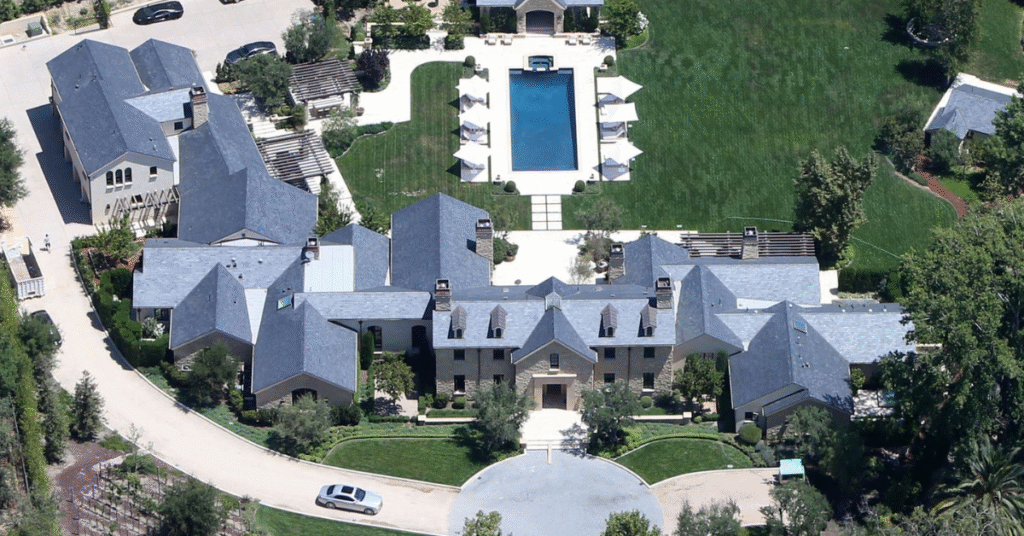When Kim Kardashian opened the doors to her Calabasas home for Architectural Digest, the world witnessed a radically unexpected side of her personal aesthetic. Far removed from the high-glamour Hollywood image she’s known for, her home reveals a deep fascination with minimalism, silence, and serenity. Inspired by monastic architecture, the house is a study in restraint, texture, and curated stillness. This isn’t just a celebrity home—it’s an architectural statement. Let’s take a deep dive into the design philosophy, materials, collaboration, and emotional intent that shaped one of the most iconic modern celebrity homes of the decade. A Collaboration with Design Legends The design of Kim’s mansion is largely the result of a creative partnership with Belgian designer and art curator Axel Vervoordt, a master of warm minimalism. Known for his ability to transform spaces into serene, meditative environments, Vervoordt brought an aesthetic that prioritizes wabi-sabi (the Japanese philosophy of imperfection), natural textures, and elemental balance. Kim has described the home as a “minimal monastery”, a space where simplicity and silence dominate. It's a house designed not to impress with opulence, but to provide peace and clarity—a haven in contrast to her otherwise hyper-public life. Minimalism Reimagined: The Power of Subtraction What sets this home apart is how far it pushes the concept of minimalism. Rather than simply using clean lines and pale tones, the house feels spiritually bare. Walls are smooth and curved like soft plaster; floors are limestone or natural wood. Doors often blend into walls, and ceilings slope …
Inside Kim Kardashian’s Monastery-Inspired Mansion

When Kim Kardashian opened the doors to her Calabasas home for Architectural Digest, the world witnessed a radically unexpected side of her personal aesthetic. Far removed from the high-glamour Hollywood image she’s known for, her home reveals a deep fascination with minimalism, silence, and serenity. Inspired by monastic architecture, the house is a study in restraint, texture, and curated stillness.
This isn’t just a celebrity home—it’s an architectural statement. Let’s take a deep dive into the design philosophy, materials, collaboration, and emotional intent that shaped one of the most iconic modern celebrity homes of the decade.
A Collaboration with Design Legends
The design of Kim’s mansion is largely the result of a creative partnership with Belgian designer and art curator Axel Vervoordt, a master of warm minimalism. Known for his ability to transform spaces into serene, meditative environments, Vervoordt brought an aesthetic that prioritizes wabi-sabi (the Japanese philosophy of imperfection), natural textures, and elemental balance.
Kim has described the home as a “minimal monastery”, a space where simplicity and silence dominate. It’s a house designed not to impress with opulence, but to provide peace and clarity—a haven in contrast to her otherwise hyper-public life.

Minimalism Reimagined: The Power of Subtraction
What sets this home apart is how far it pushes the concept of minimalism. Rather than simply using clean lines and pale tones, the house feels spiritually bare. Walls are smooth and curved like soft plaster; floors are limestone or natural wood. Doors often blend into walls, and ceilings slope subtly to guide the eye gently rather than abruptly.
There is an intentional lack of ornamentation. Light sources are concealed; decorations are almost nonexistent. Instead of being cold, the space radiates warmth due to the use of tactile materials and warm neutrals. Every detail is intentional—from the texture of the walls to the placement of a single stone bowl.
Vervoordt once said, “It’s not about a style, it’s about a philosophy.” In Kim’s mansion, that philosophy is silence and softness—creating room for the mind to settle.
Philosophy of Stillness: A Monastic Vision
Kim’s house is not minimalist in the way of sharp-edged ultramodernity. Instead, it draws on the monastic ethos—a spiritual minimalism that values slowness, intention, and imperfection. Inspired by Japanese wabi-sabi, the design embraces the beauty of natural wear, imperfection, and raw materials.
The home exudes a sense of retreat—void of visual clutter, rich in emotional calm. Light filters in softly. Surfaces are matte. Curves replace corners. Everything evokes silence and introspection.
Material Palette: Earthy, Textured, Intentional
From a material standpoint, the home stays radically consistent and deeply tactile. The surfaces are soft and sensuous—achieved through lime plaster walls, concrete floors, bleached woods, and cotton-linen upholstery. Each material was chosen for its natural, unpolished quality.
The color palette throughout the house is off-white, cream, pale beige, and stone, offering a sense of continuity across all rooms. This subdued palette is not sterile—it’s warm, earthy, and deeply immersive.
The Entryway: Portal to Peace
The journey begins at the entry corridor, often compared to a gallery or sacred cloister. It’s intentionally bare, drawing focus to light, proportion, and texture. The passage feels more like a spiritual experience than a domestic one—an intentional transition from the outer world into inner calm.
The curved ceiling and indirect lighting create a celestial effect. There are no distractions—only space, form, and quietude.
The Kitchen: Function Disguised as Sculpture
Even the kitchen, typically the heart of family activity, retains a spiritual serenity. The massive central island looks like a solid stone sculpture—free of visible appliances or clutter. Cabinet handles are almost invisible. There’s no visual noise, yet it functions seamlessly for a family of five.
Behind the minimalist façade lies hidden practicality—concealed storage, state-of-the-art equipment, and functional flow. It’s a kitchen made for living, not just admiring.
Children’s Spaces: Minimalism Meets Playfulness
One might expect such a house to be inhospitable to children—but the Kardashian-West kids have their own vibrant sanctuary. While Kim’s personal spaces are serene, the children’s bedrooms and playroom break from the monotone.
Designed with color, creativity, and softness in mind, these spaces include everything from a stage with velvet curtains to a full art studio. What’s striking is the balance—these playful spaces still echo the home’s overall aesthetic of intentional design.
Bathroom and Bedroom: The Essence of Calm
Kim’s bathroom gained viral fame for its mysterious sink—flat surfaces with concealed drainage. But beyond the sink, the space features curved vanities, arched passageways, and neutral tones that exude spa-like tranquility.
The master bedroom is a sanctuary within a sanctuary. Devoid of art, accessories, or even standard furniture, it focuses on restful space. A plush bed with creamy linens, organic textures, and massive windows creates a place for mental and physical repose.
Art, or the Lack Thereof
Surprisingly, the house includes very little traditional art. Instead, the architecture itself becomes the art—light, shadow, material, and form are the primary expressions. In rare cases where art is present, it’s usually abstract, monochrome, and deeply spiritual—like Anish Kapoor sculptures or custom installations that echo silence.
Emotional Architecture: A Mother’s Retreat
Beyond the aesthetics, what truly defines Kim Kardashian’s home is the emotional architecture. As a mother, business mogul, and media icon, Kim wanted a space that shields her and her children from the intensity of the outside world.
In a sense, the mansion functions as a retreat—a modern monastery for a 21st-century celebrity. It’s where spirituality meets design, where luxury is defined not by excess but by emptiness and peace.
Criticism & Public Fascination
The house has drawn both awe and critique. Some see it as a masterpiece of restraint, while others mock it as “a beige spaceship” or “too cold to live in.” But perhaps that’s the point. It challenges our assumptions about celebrity culture, luxury, and what a home should be.
It reflects a radical kind of vulnerability—stripping away glamour to reveal a desire for stillness and clarity.
Conclusion: A Cultural Shift in Celebrity Homes
Kim Kardashian’s monastery-inspired mansion defies expectations. In an age when celebrity homes are often showcases of wealth and maximalism, her retreat into serenity and simplicity signals a deeper cultural shift. It reveals a yearning for calm, intentional living, and mental space—even at the highest levels of fame.
This is not just a house—it’s a statement. A space where material minimalism meets emotional richness. Where every wall, curve, and shadow has purpose. Where design is not about display, but about discipline and depth.


